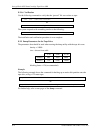
StorageWorks 8505 8mm Cartridge Tape Drive SBB
E–2 Order Number: EK–STWCT–UG. E01
this time will check the kernel to determine if the necessary drivers are built in, displaying
the results.
If necessary, the program will rebuild the kernel. If this occurs, you will have to reboot the
system in order to use the tape drive.
For further information on adding tape devices, refer to Hewlett-Packard’s Installing
Peripherals manual, P/N B2355-40041.
E.2.1.3 Device Files (Series 700)
The System Administration Manager program automatically creates the appropriate device
files and places them in the /dev/rmt directory.
The following naming convention is used on Series 700 computers for the EXB-8505
Cartridge Tape System SBB, as shown in the examples listed below:
/dev/rmt/c#d#[hlmc][n][b]
where:
c# specifies the controller designation, which may contain either two or
three characters, specifies the following:
where # is sc[f], in accordance with the following:
s is the system bus module:
2 = core I/O (the default)
4 = EISA
c is the slot number:
0 for core I/O
4 for EISA
f is the function number. This value identifies the location on the core I/O
bus. For the single-ended SCSI interface, the value is 1. If you are using
the EISA bus, omit the f value.
d# designates the SCSI address of the tape drive, where # here identifies a
number value.
h/l/m/c indicates density, with h meaning high density (EXB8200c format), l
meaning low density (EXB8200 format), m meaning standard DDS
format (EXB8500 format), and c meaning data compression (EXB8500c
format.
n indicates no rewind.
b specifies Berkeley behavior.


















